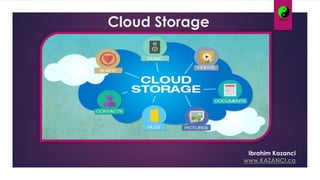
Cloud storage
- 2. Introduction A service model in which data is maintained, managed, backed up remotely and made available to users over a network (typically the Internet) The physical storage spans multiple servers (and often locations), and the physical environment is typically owned and managed by a hosting company . These service may be accessed through a co-located cloud computer service, a web service application programming interface (API) and other application that utilize API . Examples:OneDrive, Dropbox, Google Drive
- 3. History 1. Joseph Carl Robnett Licklider had a vision–one of a global connection that provided all people with an internet connection access to an overarching storage system 2. In 1960s the computer scientist with his work on ARPANET succeed in introducing first viable way to send data through packets 3. He has been called "computing’s Jonny Appleseed", for planting the seeds of computing in the digital age
- 4. 4. In 1892 IBM introduced Ethernet that allowed the incredibly fast yet inexpensive online storage to begin 5. AT&T launched PersonaLink Services – an online platform for personal and business communication and entrepreneurship storage 6. In 2006 Amazon Web services introduced their cloud storage service AWS S3 and has gained widespread recognition and adoption as the storage supplier to popular services such as Smugmug, Dropbox, Synaptop and Pinterest .
- 5. Characteristics Made up of many distributed resources, but still acts as one, either in a federated or a cooperative storage cloud architecture Highly fault tolerant through redundancy and distribution of data Highly durable through the creation of versioned copies Typically eventually consistent with regard to data replicas
- 6. Private ❖ Single tenant implementation ❖ Owned and operated by IT organization ❖ Define your own management policies ❖ Self-service ❖ Combination for private & one or more public clouds ❖ Allows IT organizations to become brokers of services Public ❖ Multi-tenant implementation ❖ Owned and operated by service provider ❖ Bound by multi- tenant data management policies ❖ Similar self service as private Hybrid Types of cloud storage
- 7. Merits 1. Storage of data via internet 2. Easy to use 3. Accessible from anywhere through internet 4. Available of emergency backup 5. Cost Savings Cloud storage
- 8. Demerits 1. Less data security 2. Need of Internet 3. Can be expensive 4. Same software required 5. High speed of internet required Cloud storage
- 9. Conclusion Cloud storage can be beneficial for an organization as well as an individual . It should be used wisely for one’s upliftment .
- 10. Thank you Ibrahim Kazanci - www.KAZANCI.ca Qualitia Ventures Corporation www.Qualitia.com
